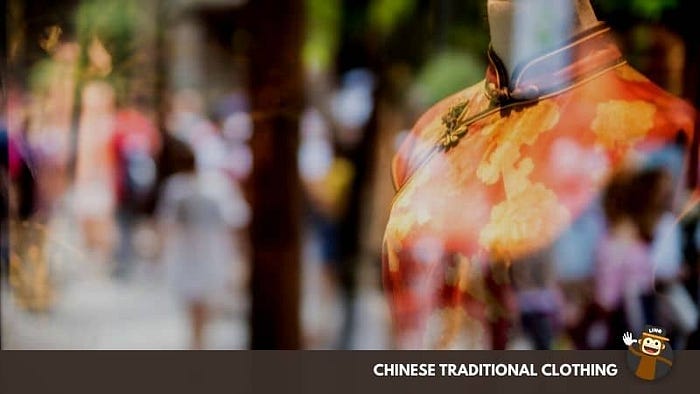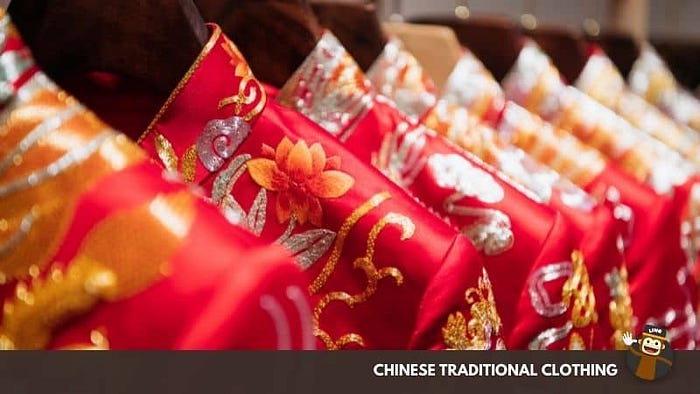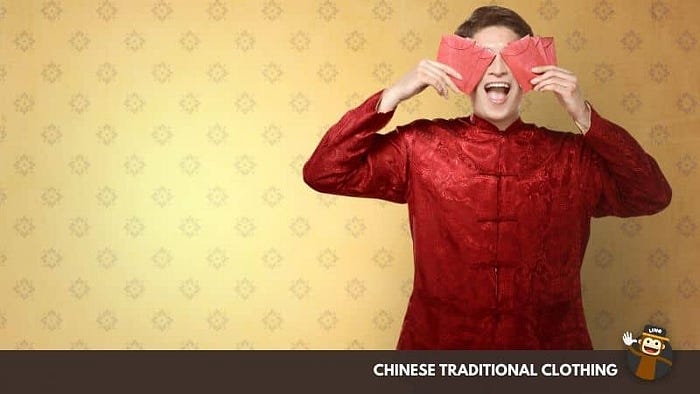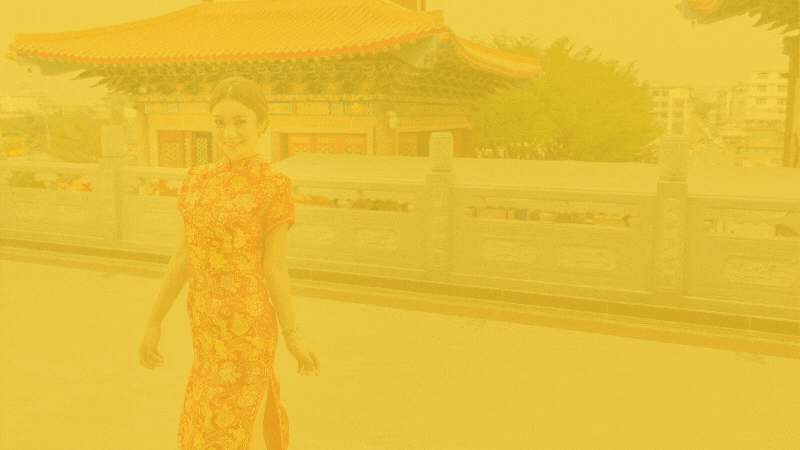4 Astonishing Traditional Chinese Clothing
Original blog post: https://ling-app.com/yue/traditional-chinese-clothing/

Have you ever wondered how Chinese Hong Kongers dress during the ancient era? Let’s travel back in time and learn about Chinese traditional clothing in today’s post. If you are ready for that, keep on reading below!
Traditional clothes serve as an identity of people in a certain country. It reveals the material and spiritual civilization of a country. It also reflects the mental and emotional activities that people engage in daily. As one of the basic needs of humans, clothes are essential in our daily life.
Today, we will talk about the four main traditional Chinese clothing used by Hong Kongers on their special occasions. You will also learn how to write these traditional clothes using Chinese characters if you are also interested in learning their language.
Brief History Of Traditional Chinese Clothing

Traditional Chinese clothing is far from the clothes we usually see in fashion shows like Pradasphere Travelling Exhibition 2014 in Hong Kong, Valentino Haute Couture 2019 in Beijing, and Chanel Pre-Fall 2009/2010 in Shanghai. The Chinese clothing culture has a long history which made a huge impact on China and Hong Kong’s society today. Here is a brief history of ancient Chinese clothing through the different dynasties.
Han Dynasty (206 BCE-220 CE)
The Han dynasty (206 BCE-220 CE) was China’s second imperial dynasty, and it was a prosperous period for the country. It is considered one of China’s most powerful and important dynasties. Many ethnic groups in China have a long history, but the Han people have dominated most of history. I’m sure that you heard about this dynasty when you studied or studied world history. But, being the most powerful dynasty, how would you imagine their clothes would be?
This period was notable for its “dark style,” which used materials in black and crimson. Han clothing patterns and fashions for Chinese men and women were nearly identical. Different colors, textiles, and ornaments were utilized to differentiate the Han women and Han men. The Han people’s clothes have very wide sleeves and a layered style, with clothes usually consisting of two or three garments, primarily a loose open cross-collar garment, a long wrap skirt, and an open cross-collar robe wrapped around the waist.
Tang Dynasty (618–907)
When it comes to cultural development, the Tang dynasty is the one to talk about. The traditional attire during this period experienced a great change because of the introduction of new dyes and more fabrics from the neighboring countries. Because of this, the Tang dynasty clothing became more colorful, and Tang people became more conscious about their outfits. Because the state was more accessible to the outside world, people’s clothing was more diversified.
The primary materials used in clothes were wool, linen, and silk; however, silk signifies high status, so it was only exclusive to the noble classes like the royal family. It is also costly, so ordinary people can’t afford it.
All social classes could freely use colors except gold and yellow. These colors were the exclusive colors of the royal family and the emperor. Eventually, these colors evolved to become an imperial symbol.
Men’s clothing during this era is more of a continuation of the clothing styles in the Han dynasty, but men have more options. Solid-colored robes with rounded collars were worn daily, usually with leather belts and boots.
Women’s clothing might be described as stylish since it changed frequently and was flashy. Women wore long-sleeved blouses with broad sleeves and collars that exposed cleavage. These shirts were tucked into long flowing skirts embroidered with geometric patterns and held by a sash knotted across the chest, which were regarded as highly provocative and daring compared to earlier dynastic fashion styles.
Makeup during this era was also quite bold. With drawn-on eyebrows, lead face powder creates a white skin illusion, and flower-like patterns are applied between the brows.
Ming Dynasty (1368–1644 CE)
Following the Mongol-led Yuan dynasty, the Ming dynasty was a Han ethnic majority regime. Clothing styles during the Ming dynasty were similar to those seen during the Han dynasty, but with one difference: foreigners and ethnic minorities were not present. The main reason for this is the restoration of Han control and enhancing Han culture and the Han people’s sense of identity.
Men’s and women’s clothing is different, but embroidered capes became a feature of both men’s and women’s dress ensembles. These capes usually had a straight collar and open sleeves. Men’s and women’s clothing is different from one another.
Men wore square collars and patterns. These patterns or markings are mostly embroidered designs such as plants, geometric patterns, and animals. Another exciting thing about this pattern is it was used to distinguish between rank and social class. Men also wore hair buns, and the officials wore a black hat with two wing-flaps on each side called futou.
On the other hand, women wore more modest clothes, usually floor-length skirts with midi-length upper garments, which created an elongated silhouette. There is another essential piece of clothing for women called ǎoqún (袄裙 ou2 kwan4) which is a pleated skirt with a cross-collar cotton top that reached down below the waist, was another sort of style. The use of light and pastel hues was prevalent.
Qing Dynasty (1636–1912 CE)
Clothing became graceful, balanced, and majestic during the Qing Dynasty. The world witnessed enormous changes over the 200 years of the Qing Empire, such as the Renaissance in Italy and Columbus’ discovery of the Americas. Still, traditional Chinese attire was unaffected by these developments due to China’s closed-door policy.
The clothing during the Qing dynasty was described as incredibly complicated. Qi people still donned attire that indicated their social status and lifestyle. You can easily know the rank of a person based on their robe. Isolation from other civilizations has left a valuable legacy for traditional Chinese clothing. There were also a lot of rules and regulations. Yellow was the dynasty’s hue, and the royal family was the only ones who could wear it.
The Manchu horsemen’s cavalry dress affected Qing dynasty fashion greatly. Initially, the Qing dynasty’s dress regulations were exceedingly strict, and many Han Chinese were forced to adopt the Manchu male hairstyle and attire or face death. However, this later became a norm that only applied to officials and scholars, not to ordinary citizens.
Men and women during the Qing dynasty have different clothes. Men wore tangzhuang (唐裝 tong4 zong1), a jacket with a straight collar inspired by the Manchu horsemen’s original three-quarter-length riding jackets. This was worn with a wrap skirt that was ankle length. The front section of the hair of Manchu men was likewise shaved, leaving the rest in a braid that hung behind their heads (called a queue).
On the other hand, women from wealthy families wore a side or front-fastening robe with a wrap-around pleated apron skirt. Traditional Manchu women grew their hair long in preparation for marriage for the hairstyle. Married ladies had a broad range of hairstyles to select from, the most popular of which was the Liangbatou (两把头 loeng5 baa2 tau4), which Empress Dowager Cixi wore. A tall headdress with two handfuls of hair parted to each side of the head and embellished with flowers and trinkets characterized this style.
Differences Between Chinese Culture And Western Culture In Clothing
In the current times, it’s easy to see the difference between Chinese fashion and western fashion. Traditional Chinese clothing seems similar to its neighboring countries like Japan and Korea. But, if you put it side-by-side with traditional western clothing, it has a huge difference.
In reality, Chinese and Western clothing cultures have developed their clothing systems. own social surroundings Because of the internet, people’s lifestyles are becoming increasingly similar. Economic and technological progress, as well as worldwide commercial trade integration. Below are the differences between Chinese culture and Western culture regarding clothes.
Clothing Concepts
Chinese people have long maintained an eastern-style conservative, influenced by Confucian thinking and Ethical Function. The skin is well-hidden and covered. Chinese garment culture is, in some ways, a “cover” culture. Body form and even skin should not be “exposed.”
On the other hand, Western clothes were employed to deny the reality of humans. The performance of their bodies depicted bodily shape in a realistic, if not overdone, manner. Clothes have been used to make something “pop,” and even differing sex features between male and female “intensity” feminine. Her skin was becoming exposed except for the time when Christianity influenced them.
Function
Since ancient times, Chinese people have placed a high value on clothes’ social and moral role. Every dynasty’s ruler has placed a high value on wearing apparel to unite people’s minds. Western, on the other hand, is far from the Chinese culture. The majority of them concentrated on clothing’s financial and aesthetic functions. Although the Romans placed a high value on the identifying function of clothing, they banned various garments during feudal times.
Material
China is known for its widely-use of silk. At the same time, Western countries use different types of material depending on the country. One example of this is the wool culture of Egypt.
Dressing Ways
Chinese apparel has separate upper and lower halves and front and back openings employing ties to secure garments for ease of removal. Western dress derived from put-on to cast-over to front-open in various styles and with intricate dressing pins or buttons are frequently used to repair garments in this technique.
Basic Forms Of Chinese Clothing

If you’ll watch a Chinese film or attend a special Chinese occasion, you will notice that their traditional clothing has two basic forms — top-bottom clothes and one-piece clothes. They could either be wearing a one-piece dress or two-piece clothing. Here’s a piece of knowledge about these two forms.
- Two-Piece Clothing — This type of clothing consists of an upper garment called yi (衣 ji1) and a lower garment called shang (裳 soeng4). Yi refers to any open cross-collar garment worn by both sexes with the right side wrapped over the left, while shang refers to any skirt worn with a side-hanging belt.
- One-Piece Clothing — Shenyi (deep robe) was a one-piece garment that dates back to the late Zhou Dynasty (1046–221 BC). Despite being cut individually, the yi and shang were sewed together as one piece. Throughout China’s history, many dynasties have widely embraced the shenyi.
What Makes A Chinese Clothing From One Another

Have you ever seen a typical Chinese tradition or celebration? If you do, you’ll notice that they have specific traditional Chinese clothing. But, if you’re not Chinese, it may be confusing to understand the differences between these traditional Chinese clothing. Below are the critical variations in traditional Chinese clothing:
- Design — For the design, harmony is the key. Traditional Chinese clothing adopted a loose shape and straight-cut design.
- Color — People use light colors in everyday life; red, bright yellow, and purple are for the emperor and royal family, red is for mass people at a wedding, and white is generally for funerals.
- Material — The most common fabrics were linen, cotton, and silk.
- Gender — Having various ornaments, objects, and styles, women’s clothing was more varied than men’s clothing.
- History — Every dynasty has its unique clothing style.
4 Main Traditional Chinese Clothing

With around 92 percent of the population being Chinese, Hong Kong influences Chinese culture in them. For those who did not know, after the Opium War, China handed up Hong Kong island to Britain “in perpetuity” in 1842, the peninsula of Kowloon was ceded in 1860, and the New Territories were leased to the United Kingdom for ninety-nine years in 1898.
The termination of the lease on the New Territories resulted in the entire territory being returned to Mainland China. Hong Kong will be controlled “with a high degree of autonomy” until 2047, according to the Sino-British Joint Declaration agreed in 1984. The guiding premise is “one country, two systems,” which means the territory can maintain its separate lifestyle and economic system for another fifty years. By this time, Hong Kong and China should be more similar.
With this, it’s no surprise that Hong Kong has the traditional Chinese culture of ancient China. One example of that is traditional Chinese clothing. Here are the four main traditional Chinese clothing is worn by Chinese people even in Hong Kong:
Hanfu (漢服 hon3 fuk6) — The Most Chinese Traditional Clothing

Chinese Hanfu (meaning “clothes of the Han people”) is the name given to pre-17th century Han Chinese traditional dress. The Han Chinese is China’s most populous ethnic group. Hanfu became the Han ethnic people’s national dress. It also significantly impacted neighboring Asian countries, including Korea, Japan, and Vietnam.
Hanfu was created between 1600 and 1000 BC during the Shang Dynasty. Hanfu was made up of a yi, a thin-cuffed, knee-length tunic with a sash, and a chang, a small, ankle-length skirt with a bixi, a length of fabric that reached the knees. They were made of silk and had red and green paint on them. Han-Chinese attire has changed and evolved with the times since its inception.
Three types of hanfu exist — a jacket with a skirt, a jacket with trousers, and a one-piece dress. Women’s jackets with skirts are the most popular style. But traditional Hanfu consists of several parts:
- yi (衣 ji1) — an open cross-collar garment
- shan (衫 saam1) — a shirt or jacket with an open cross-collar worn over the yi
- pao (袍 pou4) — a full-body garment for men
- ru (襦 ) an open cross-collar shirt)
- qun or chang (裙 kwan4) /裳 soeng4) — a skirt for both man and woman
- ku (裤 fu3)- a kid of trousers
People also wore ornaments called pei (配 pui3) to make them more decorative. These ornaments are symbols of social status. The more ornaments, the wealthier they are.
Nowadays, Hanfu is only worn on rare occasions, including festivals and wedding ceremonies. It is also worn by historical re-enactors, monks, and priests at festivals and ceremonial events or by young females who wish to show off or pose for photos.
The Cheongsam (長衫 coeng4 saam1) /Qipao (旗袍 kei4 pou4) — Traditional Women’s Clothing

Qipao, also known as cheongsam in Cantonese, is a one-piece of Chinese clothing that dates back to the 17th century in Manchu-ruled China. The qipao style has evolved and is still popular today.
Most people think of the cheongsam when they talk about traditional Chinese clothes for ladies. The qipao was originally the Manchu women’s attire during the Qing era. However, with the fall of the Qing empire in the 1920s, the qipao gained popularity in Hong Kong and Shanghai.
The cheongsam originated in the Qing Dynasty and has since evolved into Beijing, Shanghai, and Hong Kong variations. The decorations, colors, materials, and designs varied greatly.
- Beijing’s cheongsam — It is more conservative and traditional than Shanghai’s and Hong Kong’s
- Shanghai-style cheongsams — It has more commercial, forward-thinking, and more Western features in their designs and colors.
- Hong Kong-style cheongsams — It has a great influence from European culture; The decorations are also less complicated. Hong Kong-style cheongsams have shorter sleeves than Beijing and Shanghai-style cheongsams.
People are usually familiar with qipao because it is the traditional Chinese clothing seen on the internet. During Manchu control, the original qipao was oversized and baggy. It has a high neck and straight skirt characterized the Chinese garment, and it is made of silk with elaborate embroidery. It covered a woman’s whole body except for the head, hands, and toes. Today’s qipaos are form-fitting one-piece dresses with a high slit on one or both sides.
Cheongsam is also well-known worldwide, and its basic yet exotic lines have inspired many international interpretations. It is commonly used as a wedding dress in North China and is generally red. Cheongsams are often embroidered with intricate gold and silver motifs.
Women wore this elegant Chinese clothing almost every day in the 17th century. The qipao was also worn casually in Shanghai in the 1920s and Hong Kong in the 1950s. But in these modern times, qipao is no longer used in everyday lives. Women nowadays do not dress in a qipao daily. Cheongsams are now only worn at formal events such as weddings, celebrations, and beauty pageants.
Mao Suit or Zhongshan Suit (中山裝)- Traditional Men’s Clothing

The Mao suit, also known as the Zhongshan, is a kind of male attire. Sun Zhongshan (or Sun Yat-sen) created the Zhongshan suit by blending Western and Chinese clothing styles. It integrates traditional Chinese and Western clothing elements in its design. Zhongshan suits are consist of the following:
- Four pockets, two up and two down, evenly placed left and right — represent the four virtues — benevolence, loyalty, probity, and shame
- Five primary buttons on the front — represent the separation of five powers — legislation, administration, examination, jurisdiction, and supervision.
- Three smaller buttons on each sleeve — represent “the Three People’s Principles” — Nationalism, Democracy, and the People’s Livelihood.
- Two inverted pen-rack-shaped pocket flaps — represent the state’s prosperity through culture rather than military might.
- Turn-down closed collar — represents a meticulous or careful approach to state administration.
- The one-piece suit — represents the unity of China.
Because of its symmetrical structure, ample appearance, elegance, and sturdy impression, Zhongshan suits may be worn in formal and casual situations. Today, the Zhongshan suit has faded from historical prominence, as more Chinese people prefer Western-style suits. It is a result of China’s opening up and reforms in 1978. However, it has found a new life in movies and television shows. Thanks to movie stars such as Jet Li, Jackie Chan, and Donnie Yen, who wear Zhongshan suits in their roles.
Tang Suit (唐裝) — Traditional Chinese Jackets

Tang suits are only known to have existed under the Qing Dynast. It was inspired by a sort of Manchurian dress, the Magua (‘horse gown’). The Tang suit is more commonly associated with a Chinese garment than with apparel from the Tang Dynasty.
Tang suit (or Tangzhuang) comes in two styles. One is real Tang-era clothing originating in Hanfu. It has a button-less yi that overlaps the right border to the left and is linked with a sash and an ankle-length shang. This gives the impression of being free, easy, and graceful.
The other is a Manchu male’s jacket that evolved from the Magua of the Qing Dynasty. It is made by absorbing a Western-style suit cutting method, with a Mandarin collar, a frog which is a knob made of intricately knotted strings, and a duijin which is a kind of Chinese-style jacket with buttons down the front.
Today, Tang suits have evolved into formal dresses worn on special or formal occasions such as Chinese New Year, wedding ceremonies, and other major events. Tang suits, a vital aspect of traditional Chinese culture, are worn by overseas Chinese people during the Spring Festival every year, attracting many curious foreigners to try them on.
On special occasions, many young Chinese individuals prefer to wear Tang suits rather than Western-style suits and dresses. Tang suits are also preferred by Chinese TV presenters while emceeing TV broadcasts, particularly at Spring Festival Galas.
Culture And Language Are Inseparable!

Clothes are a part of a country’s culture that makes up its identity. But, you should remember that culture and language are inseparable. Besides learning about their colorful Chinese traditional clothes, why not start learning about their language?
Learning the language of a certain country is an essential part of discovering more about their culture. With this, you’ll be able to communicate with people and build a good relationship with them. So, if you want to learn Cantonese or even Mandarin, try learning with Ling App.
With Ling App, you’ll have a fun and meaningful language learning experience to help you achieve your goal in record time. With its advanced features developed by language experts and native speakers, your language skills will be developed meaningfully. With Ling App, learning can be convenient, fun, and effective. So, suit yourself up before you go to Hong Kong. Learn Cantonese now!
